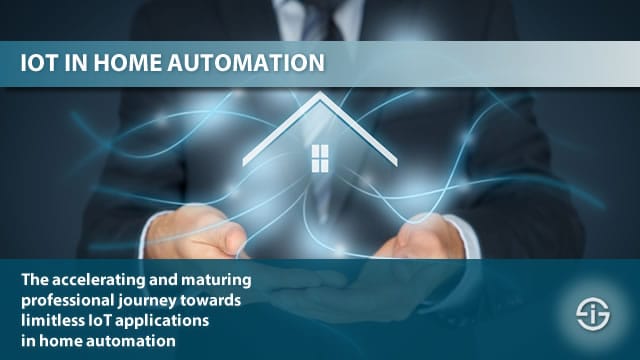The link between wine bottles, living fish, audio, your garden, a good swim, asthma and the Internet of Things: the accelerating growth of IoT home automation in the age of the true connected smart home.
The light and room control space is changing rapidly with the advent of IoT. Light and room control is pretty ubiquitous since many years in professional building management environments and increasingly moves up in home automation and the smart home, one of the main growth areas of IoT investment until at least 2021.
The list of professional IoT home automation applications is poised to exponentially grow with both individual connected devices and validated multifunctional systems
According to building management and IoT expert Jean Commeignes, who is responsible for the L&RC (Light and Room Control) badge within the awarded EcoXpert program, the key scope of IoT in light and room control will be in home automation with far more IoT applications. And it’s not just in the often ad hoc and rather simple light and room control solutions out there today but in ‘smaller’ building management systems too.
We’re indeed also talking about professional light and room control as it evolves and starts to converge with other smart building areas. Expect an increasing number and diversity of actors in the professional home automation solutions space on top of, among others, electrical contractors and system integrators, whereby professional means more integrated (home owners want integrated solutions, not in the least because of ease of use and user experience) with IoT solutions for home automation playing a de facto converging role.

The time to thoroughly understand IoT for home automation is now
As the smart home market sees growing investments and continues to mature, we also see an uptake of ever more smart home automation applications, each designed for a specific audience and some going mainstream regardless of the context of the owner.
Typical examples of such increasingly mainstream applications: home security and anything with regards to energy efficiency and savings. A typical example of a specific home automation solution that is poised to grow in a context of the drivers of IoT in healthcare: IoT-enabled solutions for the physically less mobile (among others aging populations), disabled or chronically ill (with for instance remote health monitoring and air quality monitoring).
In an interview on the evolutions in light and room control Commeignes forecasts that we are moving towards endless applications in a home automation context. IoT will simply be a game changer here, also in combination with protocols such as KNX.
For light and room control, the key scope of IoT is without any doubt in home automation, with endless applications
However, as the few examples above show it’s clear that, depending on the type of application, partners with different expertise are needed. The opportunities for integrators and also niche players are huge. You can imagine that smart energy management, the many aspects of light and room control and niche solutions in areas such as healthcare require other skills.
It is one of many reasons why companies, integrators and contractors who are active in one of the several types of applications today need to get up to speed when it boils down to the Internet of Things.
When professional home automation and even integrated building automation solutions start converge and move from today’s mainly luxury, security and comfort environment to more applications and connected solutions, market opportunities arise. Do note that we are not talking about today’s fragmented ad hoc popular smart home solutions which are important, often mentioned yet rather isolated and even rarely present in a true smart home context. On the other hand, these solutions and applications are part of the overall acceleration growth of home automation and smart home applications that is upon us in the coming years. And it’s not as if there is no room for individual connected smart home devices, well on the contrary. Yet, as we’ll tackle there will be more multifunctional applications too.
Drivers in the exponentially growing list of IoT home automation applications
When thinking about smart homes and home automation most people mention applications in areas such as security systems, connected entertainment systems, light control, room control and energy management, to name a few.
Yet, in the interview Jean Commeignes cites numerous additional applications as we move towards what he sees as endless applications in the smart home, all connected in this integrated way and with customer needs, customer values/expectations and relevance of the solutions as the center of focus for all vendors and integrators that want to succeed. So, what types of applications are we finding in that growing list of IoT-driven home automation applications? A lot. We look at some but first look at a few drivers and changes.
Security (burglar alarms, door entry systems, CCTV) and audio video systems are two main areas for IoT home automation
On top of the ever important HVAC (heating, ventilation and air conditioning) applications and a strong increase in light control, which according to Commeignes is strengthened by the LED revolution, the growing list of applications is joined by changes in the systems that drive the connected home.
The devices and applications will be deployed in a more coherent way with on top of the mentioned individually connected devices, validated multifunctional systems such as pre-engineered, bundled repetitive applications and customized applications.
If you look at the list of increasing home automation applications and in what order they will grow faster a simple question, as mentioned, drives the answers: what fits the customer needs most and is most relevant for today’s and tomorrow’s home owner? We can’t emphasize this enough as it remains one of the major hurdles, certainly in the more popular ad hoc smart home space. Time after time research confirms it as you can read in several articles across this site: too expensive, security concerns not properly addressed, brand credibility and trust, too hard to use, not relevant enough and a lack of simply properly responding to real customer needs.
Those needs of course depend on the individual home owner and are really mainly emotional in nature, often even when disguised as rational demands in areas such as monetary value. As an example of how needs vary depending on the home owner: swimming! Not everyone has the luck to have a swimming pool at home, yet the IoT-enabled swimming pool is one of the many things that you can add to IoT home automation applications. By the way: do note that the smart home is not just about what’s in the home: your outdoor swimming pool or connected security CCTV camera are two examples, the irrigation of your garden another.
The growing IoT home automation applications list
Still there are some main trends with regards to the fastest growing segments of home automation applications.
Commeignes mentions security and audio video systems, energy management and so forth as leading areas. But do think about wine cellars, fridges/freezers (yes, indeed) and aquariums, among many others as well. That’s where those wine bottles and swimming fish come in. And then we haven’t even looked deeper at the many health, physical mobility solutions and assisted living solutions yet. Or sprinkler systems, watering and smart irrigation. Solutions that make life that bit healthier in the place you reside most: air quality, humidity, ozone levels (hundreds of millions of people suffer from asthma). Access and door control. The list goes on. However, security (burglar alarms, door entry systems, CCTV) seems to be the main area as research also confirms (more below).
Whatever people value most will be monitored, optimized and controlled with IoT first. And value also means money here. It’s clear that vendors need to think about this value proposition and what people really care about most first from perspectives of emotional attachment, monetary value, cost avoidance, cost savings, reassurance, property value overall and so much more.
It’s not because there aren’t that many connected swimming pools that there is no case for IoT systems integrators, home automation experts of any type of specialized company to go in that space.
Just think about all the security (e.g. children), energy (water, electricity, heating), quality (the condition of the water) and many other aspects (luxury, ecology,…) that come into play in just one application example: that smart swimming pool. If people have the money to buy a luxury pool they’ll consider adding all these possibilities whilst trying to save money through energy efficiency with systems that are a bit more expensive than your average smart light bulb.
The IoT home automation market opportunity
Speaking about money, after several years of slow growth in the smart home area, smart home investments as said are poised to grow faster in the coming years.
According to IDC, smart home investments are expected to more than double by 2020, good for a market of over $63 billion. And, according to Gartner research, home security alarm systems lead the pack today with 18 percent of all purchases.
More importantly, the research confirms the preference for integrated solutions. Quote: “Respondents are starting to see the value of one app for integrating their connected home devices, appliances and services as well as the importance of brand certification for their connected home devices and services”.
Sure, it is still relatively early days for some of the mentioned applications but the trend is clear: ever more integration and applications thanks to IoT and IoT solutions and platforms in home automation. And that app Gartner mentions for integrating connected home devices, appliances and services? It’s going to look different as the applications are poised to grow and become more diverse.
Top image: Shutterstock – Copyright: Jirsak – All other images are the property of their respective mentioned owners.


